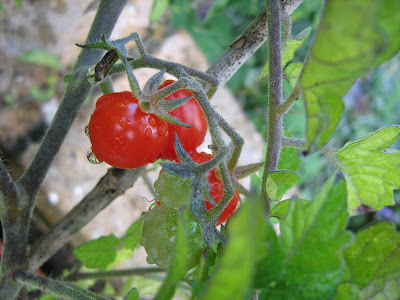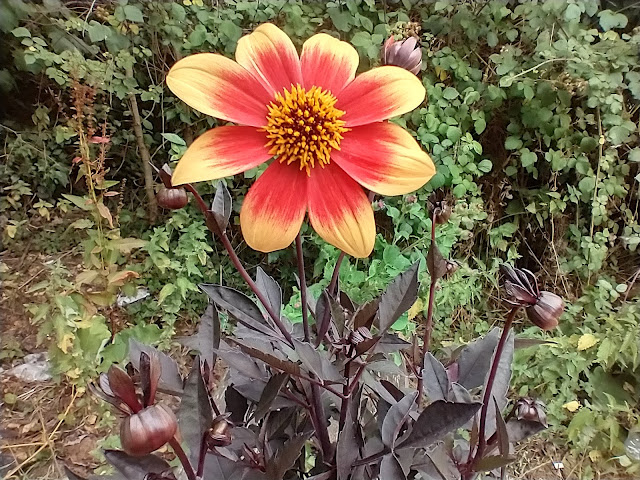On Blight Watch

The welcome drop of rain a couple of days ago combined with the continued flannel-like humidity has put me on blight watch in my garden and up at the plot. I have a number of tomato plants * here at home, plus quite a few maincrop varieties of potato up at the allotment all in a potential state of vulnerability. At least my wuthering and worrying has been calmed down a little by the discovery of a really useful website called Blight Watch. It's aimed at commercial growers but has just as much relevance to amateur ones. It's pretty clever, operating on the principle that the blight fungus needs particular conditions in which to thrive (temperature above 10 degrees centigrade for 24 hours and relative humidity above 90% for at least 11 hours) and for these to exist for 2 consecutive days. This is called the Smith Period.
Local weather records are automatically monitored for the UK and near misses, 1 day and 2 days of ideal conditions are determined. By signing up to the service I can go onto the website and see just when any of these has been recorded for my postcode. An email alert will also be sent to me whenever a Smith Period is determined for my area. I can then use this information to decide if I want to spray my crops with a precautionary fungicide** or to step up my worry and vigilance. For instance, there's been one day of ideal conditions here in the past fortnight: on August 10th.
I've also been using the Potato Council's companion Fight Against Blight website - which is linked to via Blight Watch and has oodles of useful information - particularly the distribution maps of confirmed blight cases in the UK. For a while I was reassured to see no blight recorded in my area, then realised that's because there's no Blight Scout operating around here, probably because not many potatoes are grown commercially. I contacted them about this, suggesting that there might be a role for keen amateur growers to play in enabling a full monitoring service to be provided across the UK. It turns out that they want to do just that and are currently looking for people from e.g. allotment societies to volunteer as Blight Monitors and report any suspected cases from allotment sites to them. They're really keen to get the best monitoring network possible going and I've got further information if you or your allotment/garden society are interested. The process looks simple and straightforward, so just let me know in the Comments below if you're interested or do contact them directly via the Fight Against Blight website.
If you think your tomatoes or potatoes are showing signs of blight then you might find this Potato Council leaflet helpful. It has lots of clear photos to help you with identification and is applicable to both tomatoes and potatoes as the disease and symptoms are the same for both crops. It also has information on good husbandry practice (such as watering the ground not the leaves) which will keep infestation at bay for as long as possible. If and when blight does occur, then believe it or not all is not necessarily lost if you catch it early enough: the above leaflet also tells you what you can do to save your potato crop.
In the case of tomatoes you need to strip away any infected leaves from the plant, plus any others which prevent good air circulation. Avoid splashing the leaves when watering. A good feed of liquid seaweed at this point will add to the plant's health and thus its ability to fend off the disease for as long as possible. If you're OK with using a fungicide, then you might like to use your spray of choice at this point or you could try Alys Fowler's advice re using a weekly 50/50 spray of milk and water, though I suspect she meant this to be used earlier than when the disease has actually appeared.
If blight hasn't hit yet, then this information on how to prevent it taking hold for as long as possible courtesy of My Tiny Plot via the sparkly new UK Veg Growers website may be useful and applies to potatoes as well as tomatoes. [Sorry site membership (free) is now needed to read the information]
* = yes I know I vowed never to grow any ever again after the past two years' paltry crops, but I simply couldn't resist Serendipity's kind offer of spare tomato plants when he joined us at Malvernmeet. Thanks to him we've been enjoying home grown outdoor tomatoes since the end of June :)
** = I wrote about my misgivings about that here










VP I also try to resit growing tomatoes but... My policy now is to grow from free seed, plant, water, feed, hope for the 'right' weather and dump when they get blight! I don't expect tomatoes so I am delighted this year that I am picking enough for my tea every other day. Any tomato is a bonus and I do not fuss or worry about them. I can only think that the cooler nights we have been having has kept the blight away this year - so far. I only grow early potatoes so have no problem with them.
ReplyDeleteThank you, this is a very useful post. Best wishes Sylvia
Hi Sylvia - I wish I could be as relaxed as you! The hot dry weather this year has helped: there's been far fewer Smith Periods, 1 day ideal conditions and near misses recorded so far compared to last year according to the Blight Watch website. That's the story for my postcode, though it's probably different elsewhere - Wales and NW England where they've had quite a bit of rain over the last few weeks.
ReplyDeleteGood point re only growing earlies. That's my usual approach too, but I was given some maincrops to trial hence my need for blight watching up at the plot. The earliest rfecording of blight this year was at the end of June, so growing earlies might still get caught, but the risk is very much reduced.
unfortunately, my tomatoes didn't ripen enough to get to the blight stage! being the first time i planted at this rental, i was unaware of how much calcium (lime?) was missing from the soil so my ripening ones ended up with blossome end rot. still deciding on when to amend the soil--this autumn & spring, or mainly in autumn...
ReplyDeleteI really enjoyed your post. Keep writing. You have a real talent. Thanks for sharring it with us all. Sincerely, Mike @ www.MyCarvingTree.com ...
ReplyDeleteMy potatoes will be okay as they've either been lifted or the foliage has already died back on the ones still in the ground.
ReplyDeleteThe tomatoes I'll be looking at over the weekend as I know that there was talk of blight on the site earlier in the week.
One way and another it can be a real problem that we could all do without but sadly seems to be getting worse! Flighty xx
Oh I hope not, I thought this was third time lucky on the outdoor tomato front. Thanks for the great advice, I'll be keeping my eye on them.
ReplyDeleteThanks for this really useful info VP. I'm a very keen potato grower, ie. this year I'm growing 17 varieties of taties! So I'm always worrying about blight - the service is a great idea - I've just signed up.
ReplyDeleteLike everyone else, I keep hoping against experience with tomatoes. I just remember 2006, when I had so many tomatoes that I ran out of people to give them to - everyone else was having a good year too! Since then, each summer has been crap and almost no tommies or tommies destroyed by blight before they got going. This year is better though, and I am getting a few every few days.
Blightwatch is going to be SO useful! Thanks VP.
beautiful blog..pls visit mine and be a follower.. thanks and God bless..
ReplyDeletehttp://forlots.blogspot.com/
Thanks for your comments everyone. It looks like blight has come much later this year.
ReplyDelete